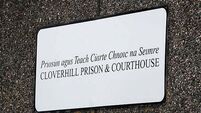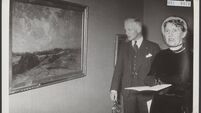‘Stupid little checklist’ may prove a lifesaver for surgeons or truck-drivers
It may be footage of something that really happened or it may not, but the fuzzy clip someone is now busily removing from websites appears to show a vast articulated truck lashing along a British motorway near Wetherby with a car stuck to its front bumper. The car is a Clio, evidently hit and picked up by the truck.
The footage went from funny to nightmare when someone who knows these things pointed out that the car’s tyres seemed to be in contact with the roadway while the truck proceeded, which, it was explained to me, could cause the car to flip. Or, as the tyres wore down, putting the metal wheel frame in contact with the road, could cause sparks, explosion and fire. Horror stuff.
Now, you will ask why the driver of the truck kept going with this unrelated decoration stuck under his nose like a vehicular version of Willie O’Dea’s moustache. Good question. The urban legend around the incident is that the driver was up so high up in his cab, that he simply couldn’t see the bumper-sticking car.
Whatever about his sight-line, you might think that the resistance provided by the car’s weight and friction against the road might have alerted the truck driver, but that doesn’t seem to have happened.
Nobody died and nobody seems to be able to pinpoint how the truck driver was eventually made aware of his unsought passenger.
Missing a Clio attached to your front bumper, if you apply Atul Gawande’s thesis to it, might result from the complexity of the task. Gawande is a surgeon and professor at Harvard who heads up the Safe Surgery Saves Lives programme for the World Health Organisation.
A surgeon friend of Gawande, exchanging war stories from the surgical front with him, mentioned the case of a talkative, overweight patient presenting after a Halloween party with a stab wound. The patient wasn’t in much pain and, looking at a small incision in his abdomen, the crew decided they had plenty of time to get him into the operating theatre, make sure his bowel hadn’t been nicked, and sew him up.
That changed when he went silent, his heart rate skyrocketed and his blood pressure went to hell in an armband.
“They stuck a tube down his airway and pushed air into his lungs, poured fluid and emergency release blood into him,” Gawande writes. “Still they couldn’t get his pressure up.”
In theatre, the surgeon sliced first into skin, then into fat, then pushed his scalpel into the abdominal cavity itself. At which point a Niagara Falls of blood came out of the patient, caused, not by the surgeon, but by the original stabber at the party, whose weapon had gone through muscle, along the spinal column and into the main artery from the heart, the aorta.
One of the other surgeons present said he hadn’t seen a wound like it since he’d served as a medic during the Vietnam War.
Which, as it turned out, was a pretty cool observation, because the weapon which had done such enormous and almost fatal damage to the patient’s insides was in fact a bayonet. It had been a costume party, and one of the guests, who had come dressed as a soldier complete with bayonet, had, when alcohol loosened his inhibitions but not his grip on the prop, impaled his fellow guest on it.
“Everyone involved got almost every step right,” says Gawande. “The head-to-toe examination, the careful tracking of the patient’s blood pressure and pulse and rate of breathing, the monitoring of his consciousness, the fluids run in by IV, the call to the blood bank to have blood ready, the placement of a urinary catheter to make sure his urine was running clear, everything. Except no one remembered to ask the patient or the emergency medical technicians what the weapon was.”
And, because bayonets are not usually the weapon of choice at contentious parties in San Francisco, nobody thought of it as the tool of destruction.
Gawande got to thinking about the bayonet incident and about other near-lethal errors he himself had made. Surgeons, these days, tend to be incredibly well educated, experienced and specialised.
The World Health Organisation’s international classification of diseases identifies 13,000 diseases, injury types and syndromes. Six thousand drugs are available. Four thousand medical and surgical procedures are frequently undertaken. The greatest challenge facing hospitals, it might be suggested, is the sheer complexity of what they now do.
Gawande’s suggestion is that the humble checklist can make a disproportionate and positive impact in complex situations, just as the pilot’s checklist has turned flying into a remarkably safe method of transport – safer than the family car.
The pilot’s checklist emerged from a disastrous crash in the 1930s, when the American Air Corps was checking out big planes for the delivery of heavy bomb payloads. One of the planes fell out of the sky and exploded, killing the pilot. “Pilot error” was to blame, the post-factum examination decided. The man in the cockpit had forgotten to release a locking mechanism mainly because, the inquiry noted, he had so many other things to take care of in such a hugely complex new machine that it might, it was suggested, be “too much airplane for one man to fly”.
A GROUP of pilots, however, thought this plane had enormous potential, so they worked out ways to cope with its complexity, chief among them a checklist the pilot had to go through each and every time he flew the plane. Using the checklist, the plane was flown nearly two million miles without accident and 13,000 of the B17 (nicknamed The Flying Fortress) were made as a result.
Applying the B17 lesson to the complexities of medicine intrigued a critical care specialist at Johns Hopkins Hospital and he addressed it to one task that happens in ICU several times a day: the insertion of what’s called a “central line” into a patient.
He made out a checklist of every step the surgeon should take before inserting such a line and then asked the nurses in ICU to observe the doctors for a month and record how often they carried out each step. In more than a third of patients, the nurses found, one of the steps got skipped.
As soon as the research pointed up these gaps, the hospital agreed that in future, if a surgeon skipped a step, the nurse had the authority to intervene. Then they studied the outcomes for a year.
Infection rates went from 11% to zero. They calculated that the checklist had prevented eight deaths and saved $2 million (€1.47m). Experiments elsewhere on other procedures mirrored that finding: lives and money saved. A lot of lives and money. Michigan – whose ICUs pushed the checklist initiative – saved almost $2m.
And all because, as Gawande says, of “a stupid little checklist”.















